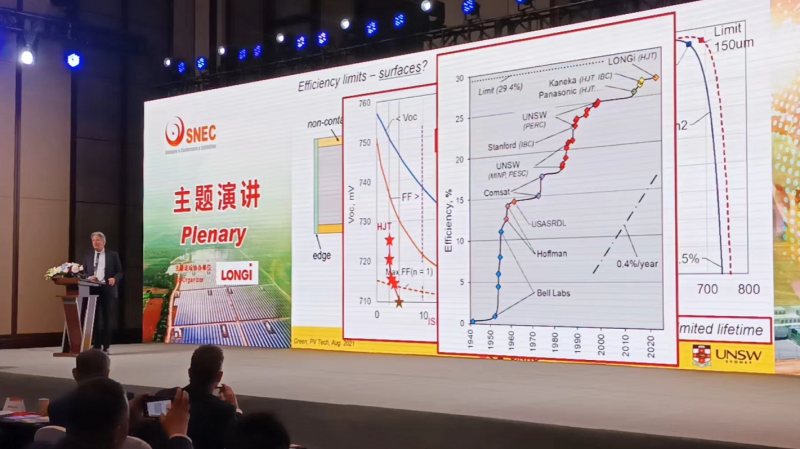PVTIME – On 23 May 2023, Professor Martin Green, known as the father of modern photovoltaics, gave a speech at the opening ceremony of SNEC 2023, the world’s largest solar event in Shanghai, China, about how close we’re getting to 29% Si cell efficiency.

Photovoltaics offers a very clean, reliable and limitless means of meeting the world’s ever-increasing demand for energy. Silicon solar cells have been the driving force behind photovoltaic technology for the past few decades due to the relative abundance and environmental friendliness of silicon.
How far solar cell manufacturers can push the efficiency of silicon cells is of interest to all major players in the industry. The limit efficiency of a silicon solar cell operating at one sun was well calculated by Professor Martin in 1984 at around 29%, and with concentrated work on solar cell technology, Professor Martin has calculated a possible maximum efficiency for p-type cells in 2022 at 29.4% (unpublished),
However, high efficiency does not translate into high wafer quality, as lifetime, packaging film and other factors are critical to the quality of a wafer. It is therefore essential for the PV industry to pay more attention to these materials in order to improve them. And the gradual improvement of wafer quality deserves years of technology development. The effects of extrinsic factors, including bulk and surface recombination, on conversion efficiency are also critical, Professor Martin emphasised.
The high efficiencies and technologies achieved by researchers in Germany, the US and Japan have dominated the industry for more than 30 years, and the Chinese have been catching up in recent years, with LONGi achieving 26.8% with its TJ-HJT3.0 cells and 26.6% with its p-type FJ cells, which are very close to the limit. And efficiency is expected to increase to 27.5% as LONGi develops the technology with higher FF and improved wafer quality, said Professor Martin.
And the world is getting to the point where China will dominate in setting of efficiency records. For the emerging IBC modules, the 23.2% efficiency achieved by LONGi’s HiMO6 p-type HPBC, the 24% achieved by Aiko Solar’s Ag-free ABC, and the 24.7% that Maxeon’s aperture cells may achieve next year, as well as the HJT5.0 full back contact cell being researched by Huasun and GS Solar, which may reach 26.8%, are all highly anticipated by the PV industry.
Therefore, to the above question of how close can we get to 29% Si cell efficiency, Professor Martin’s answer is “very close”. An efficiency of 27.5% for front and back contact HJT can be achieved with improved wafers, and 28% for IBC HJT is very feasible. For TOPCon cells, voltage improvement is essential to achieve high FFs. And IBC can be developed as an alternative to TOPCon for both polarities.












